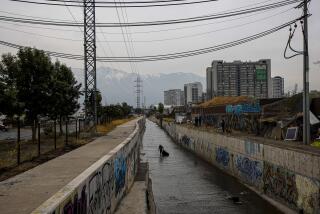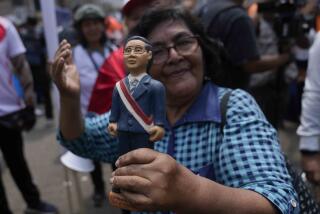Cholera Strikes 1,500 a Day in Peru : Health: Poverty and inadequate sanitation contribute to the epidemic. An international effort is under way to study and combat the disease.
- Share via
CHANCAY, Peru — When 15-year-old Daniel Caqui staggered into the hospital one night with nausea, cramps and intense diarrhea, doctors were baffled.
Vomiting and diarrhea pointed to food poisoning, but cramps suggested a sting from a venomous spider, or maybe pneumonia, said Dr. Walter Ortiz, who rushed Caqui into the emergency room that night in late January.
“I tried all the usual treatments and he just got worse. I had no idea what it was,” Ortiz remembered.
Caqui had lost consciousness and was close to death before Ortiz managed to revive him with potassium injections and quarts of serum.
Within hours, however, more and more people came to the hospital with the same symptoms. Some had such severe diarrhea that they had lost 10% of their body weight. A few died.
Not until a week after Caqui fell ill Jan. 22 did Peru’s top epidemiologists finally identify what struck him--and, by then, thousands of other Peruvians. It was cholera, an easily spread intestinal disease that can be fatal.
Starting in Chancay, on the Pacific coast about 35 miles north of Lima, a cholera epidemic has swept Peru, overwhelming its health system and threatening the rest of Latin America.
The disease has killed thousands of people in Asia and Africa since the 1960s, but no one knows exactly how the epidemic arrived here.
Experts believe Caqui, a migrant farmhand who became ill after drinking from an irrigation ditch, was probably South America’s first victim of cholera in nearly a century.
A reporter could not track him down but did find his mother. “He was as white as cotton that night,” the woman said of her son. “I was so scared and nobody could tell me what was wrong with him.”
Since then, cholera has been striking an average of about 1,500 more people every day, feeding on poverty and poor hygiene in a country where raw sewage gushes into the ocean and rivers that are used for drinking water.
The epidemic has turned Chancay, a sleepy fishing port of 50,000 people, into the front line of an international effort to study and combat a disease which, in its present form, broke out in Indonesia in 1961.
“It’s taken 30 years for the pandemic to spread across Asia and Africa and finally reach Latin America. Now that it’s implanted here, it’s here to stay,” said Jean-Paul Boutin, an epidemiologist who came to Chancay with a French medical team.
“This is a disease which killed 10,000 people in West Africa in the 1970s. The danger for Latin America is very great,” said Boutin, who has studied cholera epidemics in the Ivory Coast.
So far, the mortality rate has been low in Peru, thanks to quick prevention programs by local health authorities. Of 26,340 people stricken by Feb. 22, only 134 had died.
Health experts view the epidemic as a symptom of the economic decay that has gripped Peru for the last decade.
“Cholera is a disease of the poor, and that fact made Peru . . . very vulnerable,” said Uriel Garcia, a doctor and former health minister. “Yet, with all our problems, we were not prepared for something like this to happen.”
The bacterial disease, usually spread by tainted water or seafood, has killed some of its victims in only a few hours through acute dehydration and kidney failure.
The epidemic has also dealt a heavy psychological blow in Peru, whose people are devoutly Roman Catholic but often superstitious.
Some have speculated openly that the country of 22 million people, already brought to its knees by economic crisis and leftist guerrilla violence, was the victim of a divine curse.
“It’s like a plague, like something from the Bible, like a disease that comes and kills all the animals,” said housewife Manuela Valdez. She has seen many of her neighbors in Lima’s La Tablada shantytown come down with cholera.
Already, about one in every 850 Peruvians has been stricken with cholera. Health officials say the number could rise to about one in every 100 in the next few months.
“Epidemics and plagues of the Middle Ages are today invading us,” the Lima magazine Quehacer said. “On top of cholera, we have outbreaks of measles, tuberculosis and malaria.
“We are experiencing something that the Pharaoh of Egypt, with his seven plagues, would not envy.”
The epidemic has forced millions of Peruvians to part with a cherished national dish, ceviche, a stew of marinated raw fish and onions, which doctors say is a caldron of cholera.
In Lima, long one of Latin America’s dirtiest and most pestilent cities, hygiene has suddenly become important.
City authorities have scrubbed and fumigated markets that had not been cleaned in years.
A TV program has been showing scenes of people urinating on the street while announcing: “If you know any of these people, please tell them that Lima should not be a big latrine where our children are threatened by cholera.”
In poorer areas and in the countryside, however, old habits are tough to break.
“People in the shantytowns always tell us, ‘I’ve always drunk from the drainage ditches and never gotten sick. Why should I change now?’ ” said Ortiz, the doctor in Chancay.
“It’s difficult to explain to them that from now on, that water might carry cholera.”
More to Read
Sign up for Essential California
The most important California stories and recommendations in your inbox every morning.
You may occasionally receive promotional content from the Los Angeles Times.













